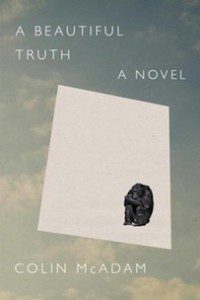
Is language what makes us human? Take Adam, whose first occupation was to assign a name to everything in Eden—if you believe in that sort of thing. He defined his world with a vocabulary that distinguished snail from eagle and everything in between. And then Eve arrived and Adam had to invent a new word, one to express something unknown, a feeling unseeable and wonderful and often confounding.
Language gives shape to the intangible and allows us to express the inscrutable. And yet language is complicated and amorphous and evolving and in the end, not enough, especially in the case of Walter Ribke and his unusual family in Colin McAdam’s novel A Beautiful Truth.
Walt is a compassionate, devoted husband, always declaring his love for his wife Judy with simple statements and gracious gestures. Their brand of earnest happiness and shameless adoration feels sadly uncommon these days, especially in fiction—perhaps that’s partially why the novel is set in the 1970s. But life for the Ribkes is incomplete: Walt, who is older, has given Judy love and wealth and comfort, but has not provided a child that would make them a “family.” And Judy has begun struggling with that absence. After reading an article about a chimpanzee’s ability to communicate with humans through sign language, Walt is inspired to acquire one with the help of a circus clown. It may seem a strange alternative to traditional adoption, but once Looee, their simian scion, arrives, the Ribkes take to parenthood quickly. As Judy realizes, “when things are truly strange their strangeness doesn’t appear until after the strangeness has passed.”
As Looee gets bigger (as chimps do) and begins to dominate their lives (as children do), Walt and Judy begin to define the dynamic. Looee is neither a child nor pet “but certainly not an animal.” So are the Ribkes actual parents or rather amateur primatologists? Meanwhile, McAdams tells another story about a group of research primates housed at the Girdish Institute. Researchers there study primate social behavior and intelligence, but the funding comes from vicious animal medical testing. This disparity raises questions about both the researchers (How can they be perceptive enough to marvel at these creatures’ humanity, while also injecting their bodies with HIV cocktails?) and the animals (Are they intelligent because they can learn our language, or because they don’t need to borrow ours?).

The scenes at Girdish alternate between the perspectives of the primates and the staff , who are often described with the same distance found in scientific field notes. In the former perspective A Beautiful Truth is particularly remarkable, in that it puts us inside the thoughts of animals that do not share our language. But instead than writing a series of phonetic grunts and howls, McAdams uses some words learned from humans as well as words that are of a more primal origin. The primates believe in “oa,” a kind of harmony, and throw their “urulek” when the testing gets too stressful. There are also efficient portmanteaus like “fearjoy” and the natural unpoetry of fractured language that yearns to describe something beyond itself: “fists more than fists like hail is more than water.” And just as humans, especially teenagers, appropriate language and reassign definitions, so do the animals of Girdish: one chimp calls everything she likes “red” and another describes two researchers in early love as looking “shiny and lucky and stupid.”
A Beautiful Truth is part of an established tradition about “humanized” chimpanzees, most notably Benjamin Hale’s debut opus The Evolution of Bruno Littlemore. But comparing chimp-lit to chimp-lit is about as useful as comparing your banana to my banana. There’s plenty of room in the literary world for insightful books about primates learning to communicate, just as there are plenty of pages—and even imprints—devoted to teenagers learning how to date.
Typically, when we anthropomorphize, we mock our subjects with caricatures. Daffy, Donald, Goofy, Sylvester, and the entire mindless zoo of I Can Has Cheeze Burger all have speech impediments that are cute and absurd and operate on the principle of a little girl wearing her mother’s shoes. These creatures appear to transcend their physical form, but the very mechanism of transformation guarantees you will never forget what they are. With apologies to Sylvester, it’s despicable.
The story of Walt, Judy, and Looee is not a sitcom about life with an “other,” like Alf or Harry and the Hendersons. Nor is it the story of an ape learning to live beyond its nature, like Congo or Curious George. McAdams isn’t trying to dazzle us with the brilliance of animal intuition or make us fawn over stupid pet tricks—he knows that a monkey in a suit is just a well-dressed monkey.
Instead McAdams challenges us to form the questions we are unable to express, to look beyond language and see how definitions impose limits on our lives. There’s that old offensive myth that Inuits have 100 words for snow. But look at how many words Americans have for discomfort (anxiety, sadness, tension, shame, fear…). And look at how worked up Americans get when someone challenges our definitions of family and marriage. And then look at how few words we have to mean love. To get beyond that one word, we need to elaborate for an entire sonnet—or even a novel.
The beauty of McAdams’ book is that it makes us look at ourselves and our lives through new eyes. Are we human because we say we are? Do I love you because I can say I do? A Beautiful Truth is a beautiful novel about consciousness and communication, about how we connect with others and our surroundings, and what it means to truly exist in the world.




